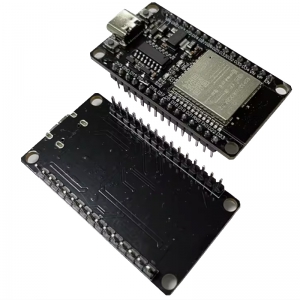
A Development Board, also known as an evaluation board or prototype board, is a platform that integrates microprocessors, microcontrollers, or other types of integrated circuits (ICs), designed to help developers quickly start designing, testing, and debugging hardware and software. A development board usually includes a series of peripheral interfaces, such as GPIO (Universal Input and Output), serial port, I2C, SPI, USB, Ethernet, etc., as well as corresponding debugging and programming interfaces.
characteristic:
Pre installed processor: The development board already has a microprocessor or microcontroller installed, eliminating the need for users to solder chips themselves.
Rich peripherals: Provides multiple standard interfaces and expansion slots for easy connection to other hardware modules or sensors.
Complete documentation: usually accompanied by detailed hardware reference manuals, software libraries, and sample code, helps developers get started quickly.
Community support: Many popular development boards have an active user community where you can find a wealth of tutorials, problem solving, and third-party resources.
Structural composition:
The basic structure of a development board includes:
Core processor: The "brain" of the development board, responsible for executing program instructions.
Memory: including RAM (Random Access Memory) and ROM (Read Only Memory) or flash memory, used to store programs and data.
Input/output interfaces: such as GPIO, ADC (analog-to-digital converter), DAC (digital to analog converter), PWM (pulse width modulation), etc.
Communication interface: such as UART SPI、I2C、CAN、Ethernet、Wi-Fi、 Bluetooth, etc.
Debugging interface: usually JTAG or SWD interface, used to connect to a debugger for program burning and debugging.
Power management: including voltage regulator and power switch to ensure stable power supply.
Common types:
The common types of development boards include:
Microcontroller development board: such as Arduino, Raspberry Pi Pico, STM32 Nucleo, etc., suitable for embedded systems and IoT projects.
Single board computers, such as Raspberry Pi, Odroid, BeagleBone, etc., have strong computing power and can run complete operating systems.
FPGA development board: such as Xilinx Zynq, Altera Cyclone, etc., suitable for applications that require highly customized logic.
SoC (System on Chip) development board: integrates multiple functions on a single chip, suitable for multimedia processing and advanced applications.
Application:
The development board is widely used in the following fields:
Educational learning: as a teaching tool for electronics, computer science, and robotics technology.
Prototype design: Quickly build product prototypes, validate concepts and designs.
Maker DIY: Individual enthusiasts and small teams engage in the research and development of innovative projects.
Industrial control: used for automation, robotics technology, and intelligent manufacturing.
Internet of Things (IoT): Building applications such as smart homes, smart agriculture, and smart cities.
Selection and Use:
When choosing a development board, the following factors need to be considered:
Processor performance: Select the appropriate processor architecture and performance level based on project requirements.
Peripherals and interfaces: Ensure that the interfaces provided by the development board meet project requirements.
Software support: Check for mature software frameworks and toolchains.
Cost and availability: Consider the cost and market supply situation of the development board.
Proper use of the development board, including familiarity with hardware configuration, mastery of programming language, use of debugging tools, and participation in community communication, is crucial for the success of the project.
Shenzhen Baoxin Chuang Electronics Co., Ltd.
Address: 45th Floor, SEG Plaza, 1002 Huaqiang North Road, Futian District, Shenzhen, Guangdong, China
Website: www.boxintron-ic.com
Tel: +86-0755-8355 3623/8322 8690/8322 8629/8322 8357
Fax: +86-0755-8366 0820
Email: service@boxintron.com
Electronic components with a single expert
Shenzhen Baoxin Chuang Electronics Co., Ltd. is committed to becoming the best IC supplier with single expert and IC agent
Strive to provide customers with one-stop electronic components procurement and IC supporting services
Tel: +86-0755-8355 3623 Fax Fox: +86-0755-8366 0820 Email: service@boxintron.com
Address: Room 4503, 45th Floor, SEG Plaza, 1002 Huaqiang North Road, Futian District, Shenzhen, Guangdong, China
![Shenzhen Baoxin Chuang Electronics Co., Ltd. [one-stop type of electronic components with one-only original authentic] Shenzhen Baoxin Chuang Electronics Co., Ltd. [one-stop type of electronic components with one-only original authentic]](templates/web/images/logo.png)